Establishment of an Organizational Risk Management Framework Report
VerifiedAdded on 2022/09/22
|7
|1073
|18
Report
AI Summary
This report focuses on establishing an organizational risk management framework for a toll road construction project by the Apha construction company in Indonesia. It begins with an analysis of the 7 W's (Who, What, When, Where, Why, Which Way, Withal) to identify potential risks. The report then assesses the organization's maturity level in risk management, progressing from reactive to proactive approaches. The core of the report outlines the risk management framework, highlighting its effectiveness in addressing various risk categories, such as economic, environmental, social, and construction risks. The report also examines the contractual instrument, specifically the fixed-price contract, and its implications for risk management. The conclusion emphasizes the importance of a systematic approach to risk management, involving all stakeholders, and the need for transparent contractual instruments to balance risks and responsibilities. The report references various sources, including academic papers and online resources, to support its analysis and recommendations.
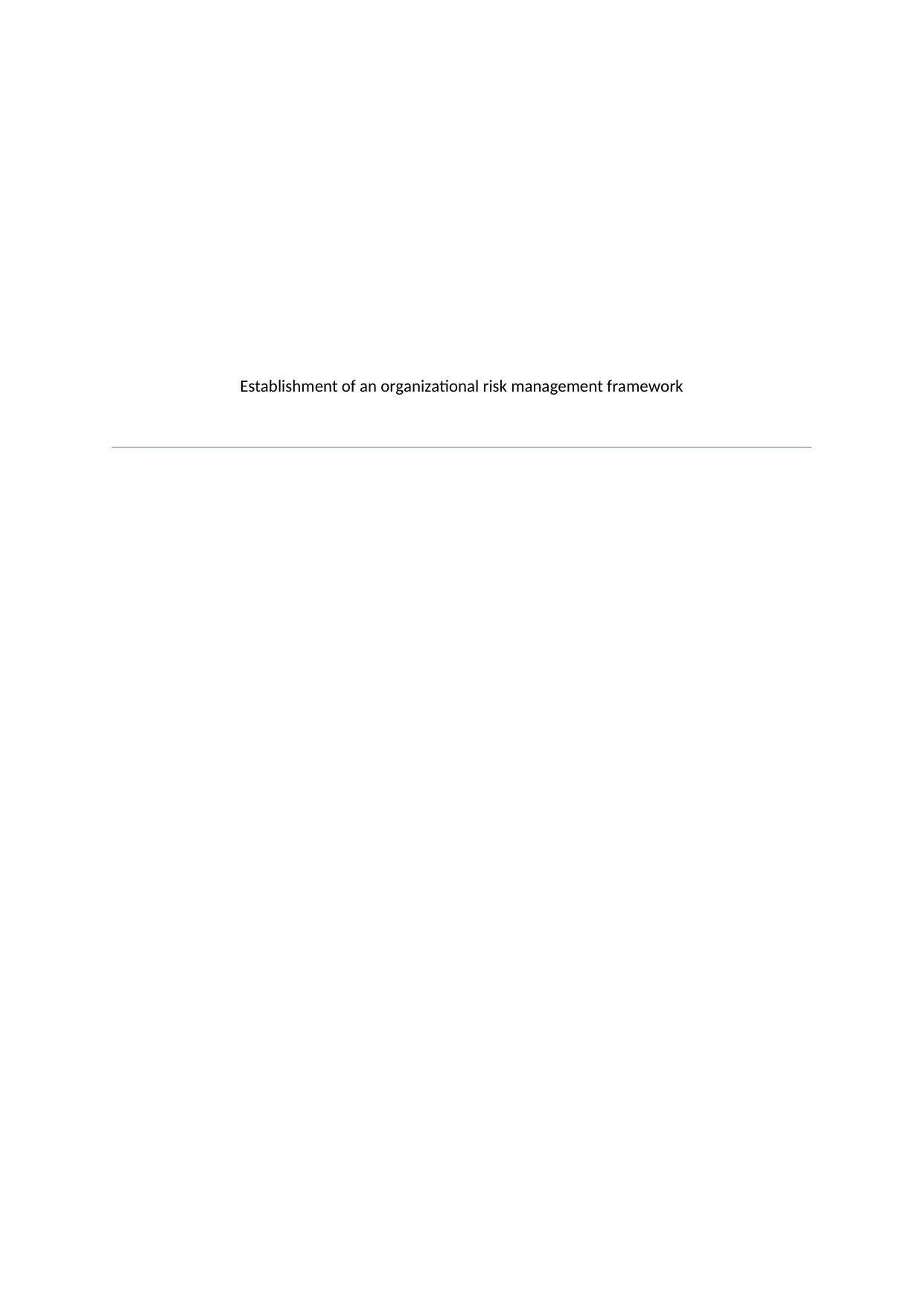
Establishment of an organizational risk management framework
Paraphrase This Document
Need a fresh take? Get an instant paraphrase of this document with our AI Paraphraser
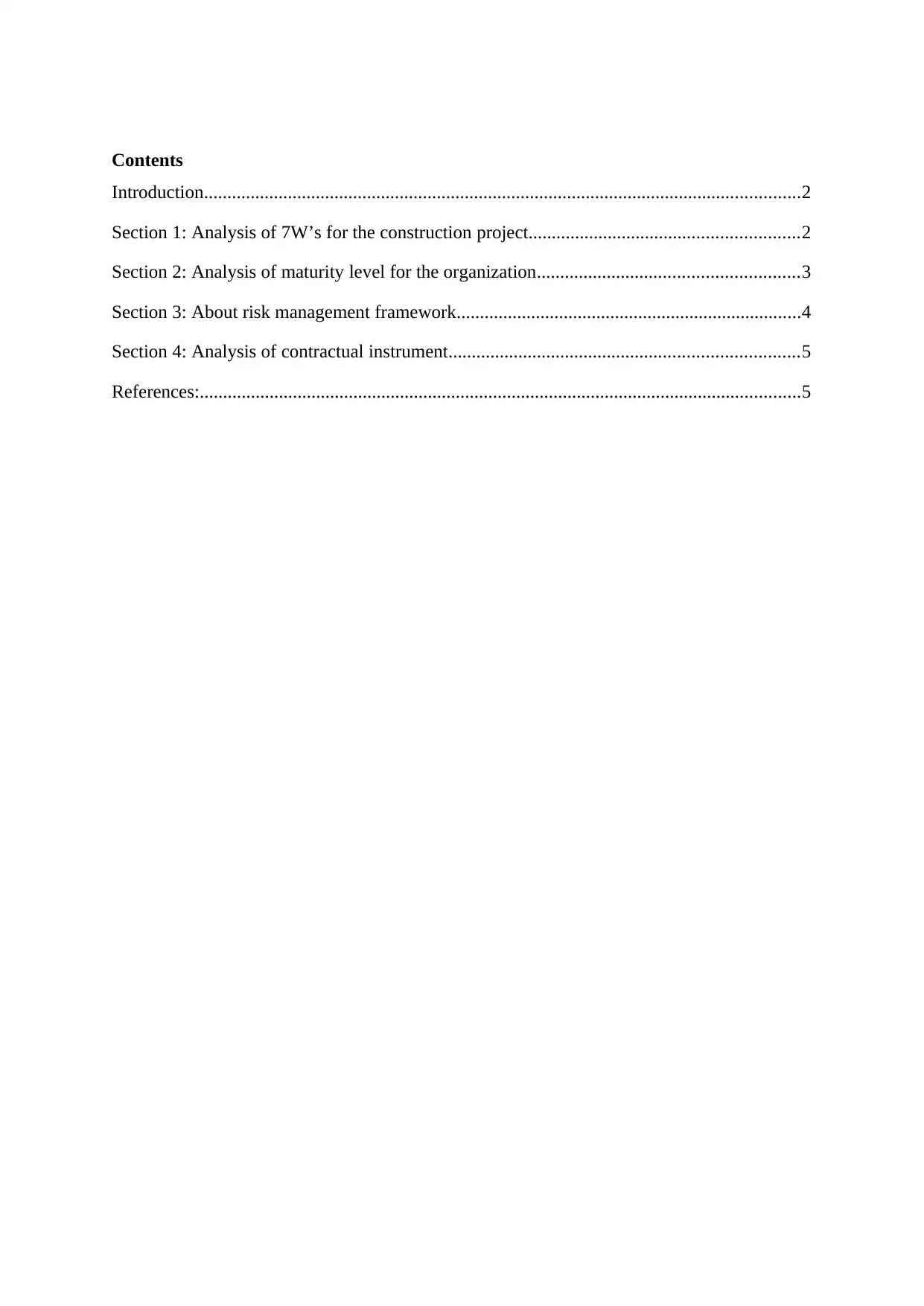
Contents
Introduction................................................................................................................................2
Section 1: Analysis of 7W’s for the construction project..........................................................2
Section 2: Analysis of maturity level for the organization........................................................3
Section 3: About risk management framework..........................................................................4
Section 4: Analysis of contractual instrument...........................................................................5
References:.................................................................................................................................5
Introduction................................................................................................................................2
Section 1: Analysis of 7W’s for the construction project..........................................................2
Section 2: Analysis of maturity level for the organization........................................................3
Section 3: About risk management framework..........................................................................4
Section 4: Analysis of contractual instrument...........................................................................5
References:.................................................................................................................................5
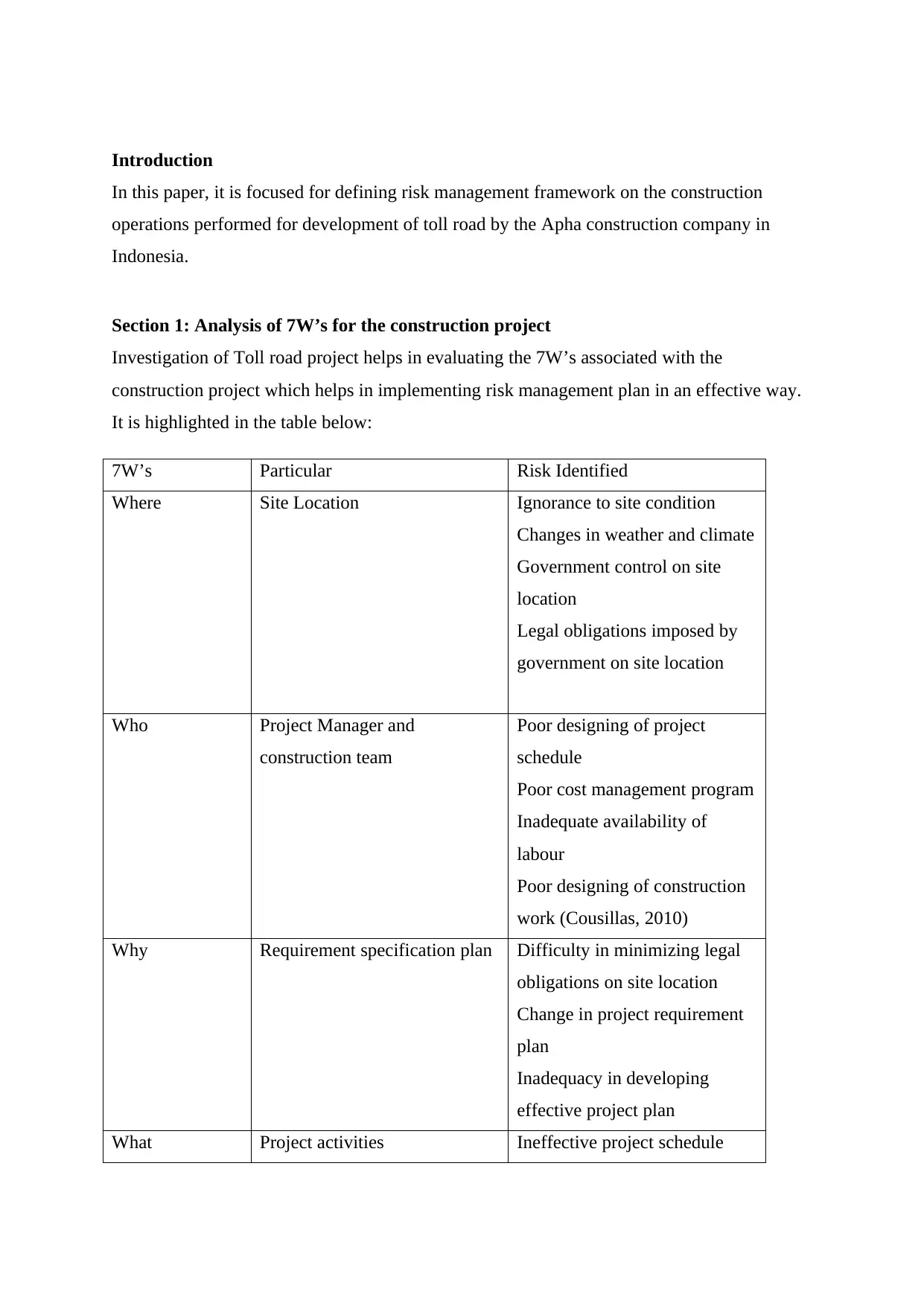
Introduction
In this paper, it is focused for defining risk management framework on the construction
operations performed for development of toll road by the Apha construction company in
Indonesia.
Section 1: Analysis of 7W’s for the construction project
Investigation of Toll road project helps in evaluating the 7W’s associated with the
construction project which helps in implementing risk management plan in an effective way.
It is highlighted in the table below:
7W’s Particular Risk Identified
Where Site Location Ignorance to site condition
Changes in weather and climate
Government control on site
location
Legal obligations imposed by
government on site location
Who Project Manager and
construction team
Poor designing of project
schedule
Poor cost management program
Inadequate availability of
labour
Poor designing of construction
work (Cousillas, 2010)
Why Requirement specification plan Difficulty in minimizing legal
obligations on site location
Change in project requirement
plan
Inadequacy in developing
effective project plan
What Project activities Ineffective project schedule
In this paper, it is focused for defining risk management framework on the construction
operations performed for development of toll road by the Apha construction company in
Indonesia.
Section 1: Analysis of 7W’s for the construction project
Investigation of Toll road project helps in evaluating the 7W’s associated with the
construction project which helps in implementing risk management plan in an effective way.
It is highlighted in the table below:
7W’s Particular Risk Identified
Where Site Location Ignorance to site condition
Changes in weather and climate
Government control on site
location
Legal obligations imposed by
government on site location
Who Project Manager and
construction team
Poor designing of project
schedule
Poor cost management program
Inadequate availability of
labour
Poor designing of construction
work (Cousillas, 2010)
Why Requirement specification plan Difficulty in minimizing legal
obligations on site location
Change in project requirement
plan
Inadequacy in developing
effective project plan
What Project activities Ineffective project schedule
⊘ This is a preview!⊘
Do you want full access?
Subscribe today to unlock all pages.

Trusted by 1+ million students worldwide
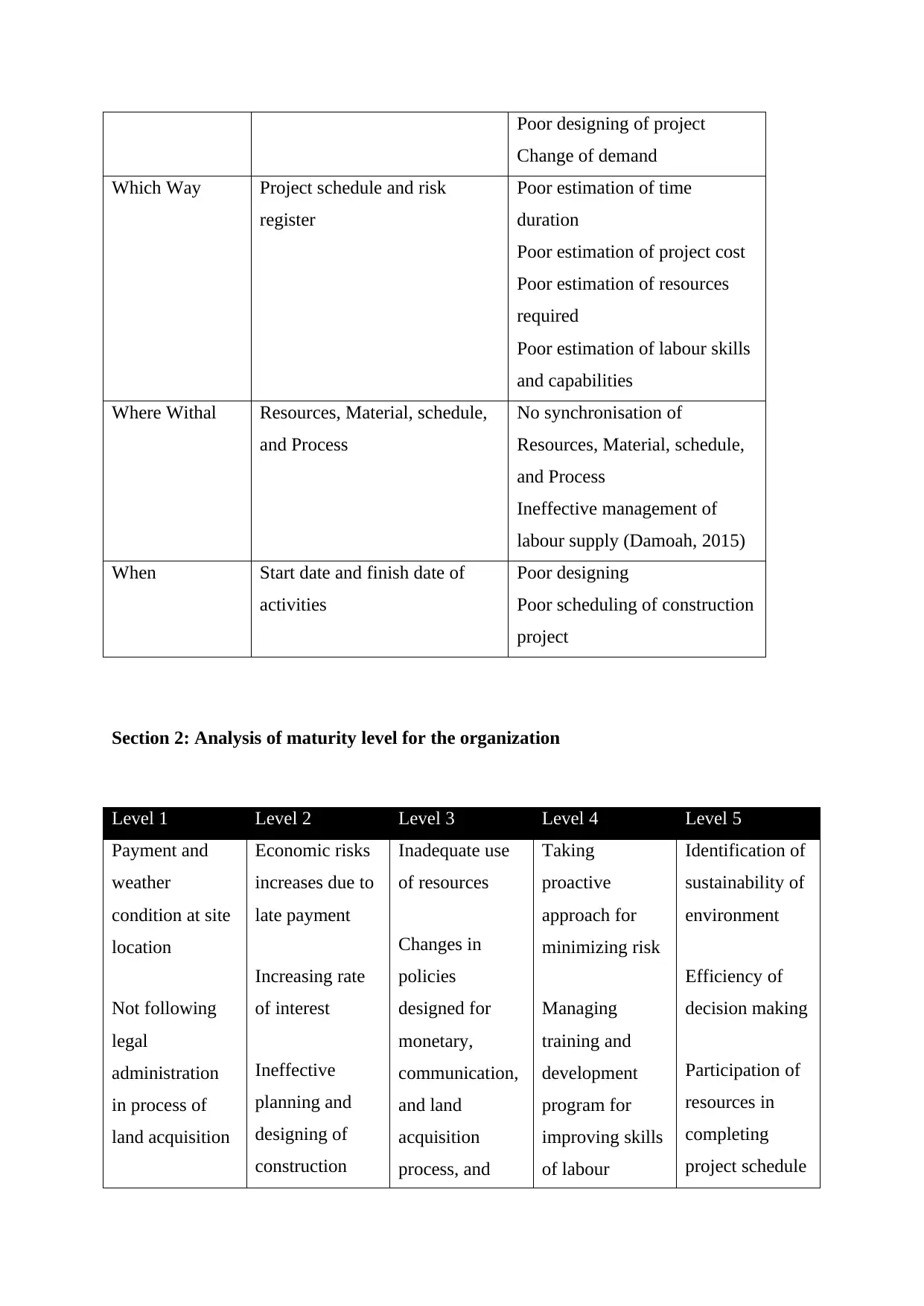
Poor designing of project
Change of demand
Which Way Project schedule and risk
register
Poor estimation of time
duration
Poor estimation of project cost
Poor estimation of resources
required
Poor estimation of labour skills
and capabilities
Where Withal Resources, Material, schedule,
and Process
No synchronisation of
Resources, Material, schedule,
and Process
Ineffective management of
labour supply (Damoah, 2015)
When Start date and finish date of
activities
Poor designing
Poor scheduling of construction
project
Section 2: Analysis of maturity level for the organization
Level 1 Level 2 Level 3 Level 4 Level 5
Payment and
weather
condition at site
location
Not following
legal
administration
in process of
land acquisition
Economic risks
increases due to
late payment
Increasing rate
of interest
Ineffective
planning and
designing of
construction
Inadequate use
of resources
Changes in
policies
designed for
monetary,
communication,
and land
acquisition
process, and
Taking
proactive
approach for
minimizing risk
Managing
training and
development
program for
improving skills
of labour
Identification of
sustainability of
environment
Efficiency of
decision making
Participation of
resources in
completing
project schedule
Change of demand
Which Way Project schedule and risk
register
Poor estimation of time
duration
Poor estimation of project cost
Poor estimation of resources
required
Poor estimation of labour skills
and capabilities
Where Withal Resources, Material, schedule,
and Process
No synchronisation of
Resources, Material, schedule,
and Process
Ineffective management of
labour supply (Damoah, 2015)
When Start date and finish date of
activities
Poor designing
Poor scheduling of construction
project
Section 2: Analysis of maturity level for the organization
Level 1 Level 2 Level 3 Level 4 Level 5
Payment and
weather
condition at site
location
Not following
legal
administration
in process of
land acquisition
Economic risks
increases due to
late payment
Increasing rate
of interest
Ineffective
planning and
designing of
construction
Inadequate use
of resources
Changes in
policies
designed for
monetary,
communication,
and land
acquisition
process, and
Taking
proactive
approach for
minimizing risk
Managing
training and
development
program for
improving skills
of labour
Identification of
sustainability of
environment
Efficiency of
decision making
Participation of
resources in
completing
project schedule
Paraphrase This Document
Need a fresh take? Get an instant paraphrase of this document with our AI Paraphraser
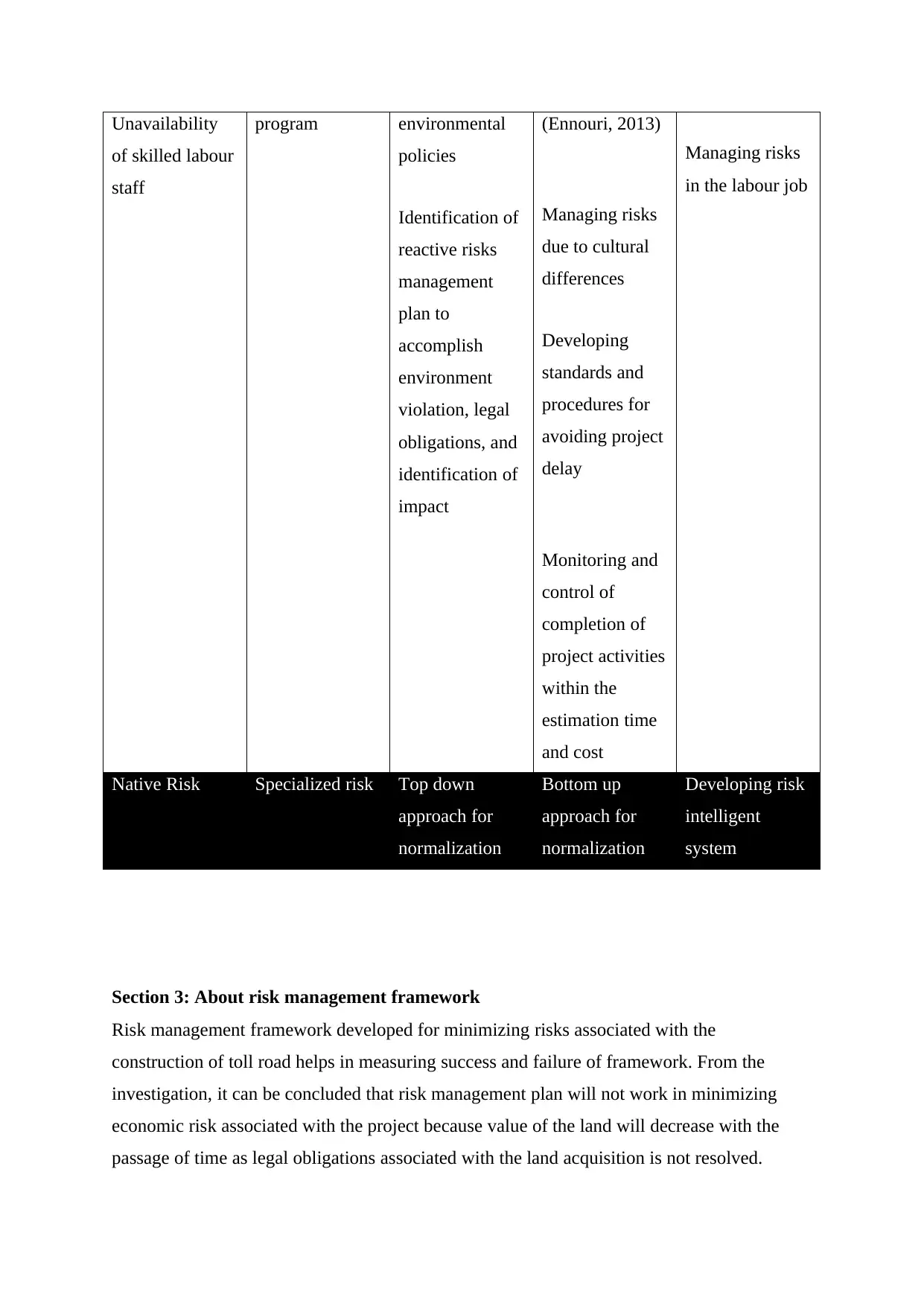
Unavailability
of skilled labour
staff
program environmental
policies
Identification of
reactive risks
management
plan to
accomplish
environment
violation, legal
obligations, and
identification of
impact
(Ennouri, 2013)
Managing risks
due to cultural
differences
Developing
standards and
procedures for
avoiding project
delay
Monitoring and
control of
completion of
project activities
within the
estimation time
and cost
Managing risks
in the labour job
Native Risk Specialized risk Top down
approach for
normalization
Bottom up
approach for
normalization
Developing risk
intelligent
system
Section 3: About risk management framework
Risk management framework developed for minimizing risks associated with the
construction of toll road helps in measuring success and failure of framework. From the
investigation, it can be concluded that risk management plan will not work in minimizing
economic risk associated with the project because value of the land will decrease with the
passage of time as legal obligations associated with the land acquisition is not resolved.
of skilled labour
staff
program environmental
policies
Identification of
reactive risks
management
plan to
accomplish
environment
violation, legal
obligations, and
identification of
impact
(Ennouri, 2013)
Managing risks
due to cultural
differences
Developing
standards and
procedures for
avoiding project
delay
Monitoring and
control of
completion of
project activities
within the
estimation time
and cost
Managing risks
in the labour job
Native Risk Specialized risk Top down
approach for
normalization
Bottom up
approach for
normalization
Developing risk
intelligent
system
Section 3: About risk management framework
Risk management framework developed for minimizing risks associated with the
construction of toll road helps in measuring success and failure of framework. From the
investigation, it can be concluded that risk management plan will not work in minimizing
economic risk associated with the project because value of the land will decrease with the
passage of time as legal obligations associated with the land acquisition is not resolved.
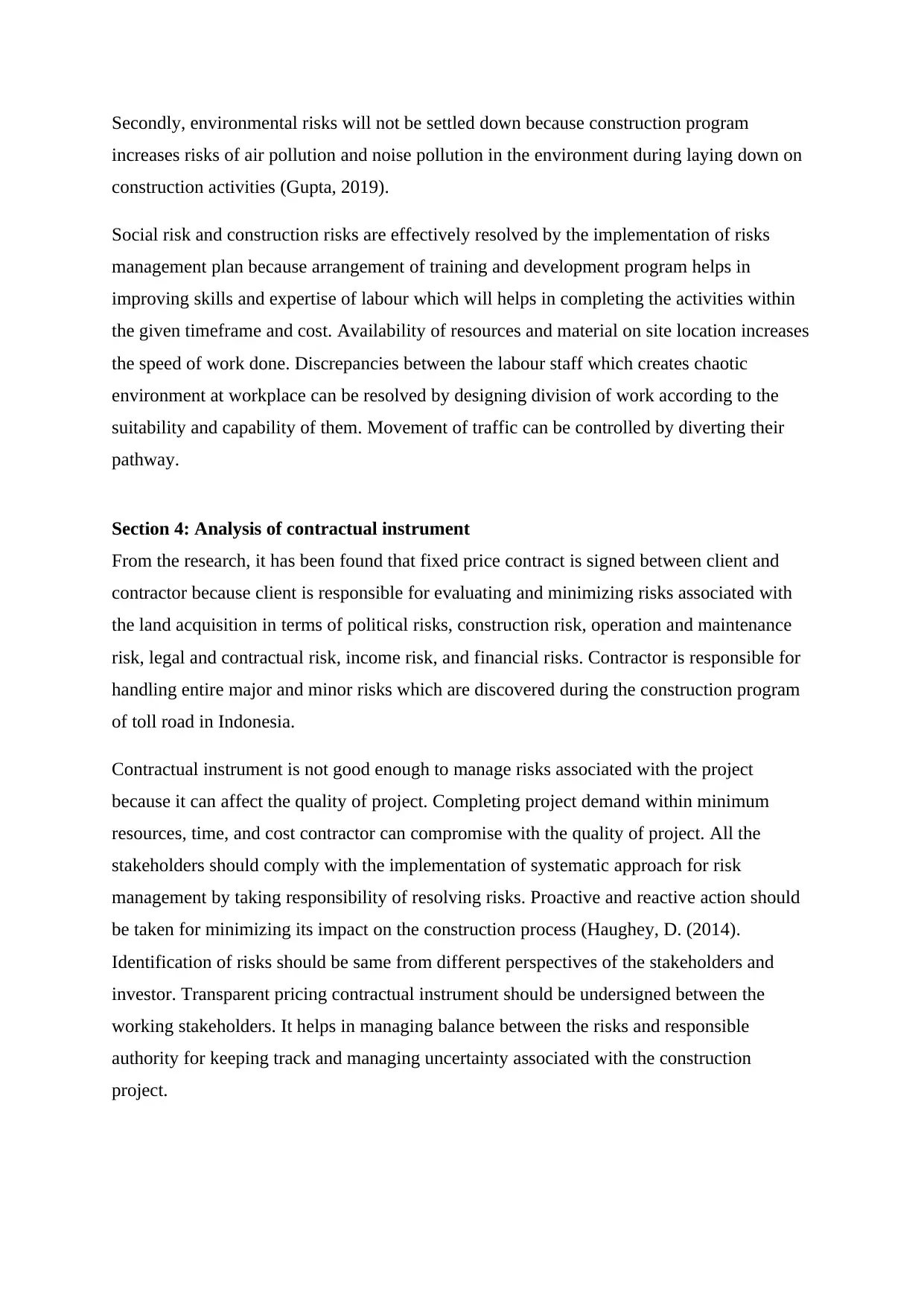
Secondly, environmental risks will not be settled down because construction program
increases risks of air pollution and noise pollution in the environment during laying down on
construction activities (Gupta, 2019).
Social risk and construction risks are effectively resolved by the implementation of risks
management plan because arrangement of training and development program helps in
improving skills and expertise of labour which will helps in completing the activities within
the given timeframe and cost. Availability of resources and material on site location increases
the speed of work done. Discrepancies between the labour staff which creates chaotic
environment at workplace can be resolved by designing division of work according to the
suitability and capability of them. Movement of traffic can be controlled by diverting their
pathway.
Section 4: Analysis of contractual instrument
From the research, it has been found that fixed price contract is signed between client and
contractor because client is responsible for evaluating and minimizing risks associated with
the land acquisition in terms of political risks, construction risk, operation and maintenance
risk, legal and contractual risk, income risk, and financial risks. Contractor is responsible for
handling entire major and minor risks which are discovered during the construction program
of toll road in Indonesia.
Contractual instrument is not good enough to manage risks associated with the project
because it can affect the quality of project. Completing project demand within minimum
resources, time, and cost contractor can compromise with the quality of project. All the
stakeholders should comply with the implementation of systematic approach for risk
management by taking responsibility of resolving risks. Proactive and reactive action should
be taken for minimizing its impact on the construction process (Haughey, D. (2014).
Identification of risks should be same from different perspectives of the stakeholders and
investor. Transparent pricing contractual instrument should be undersigned between the
working stakeholders. It helps in managing balance between the risks and responsible
authority for keeping track and managing uncertainty associated with the construction
project.
increases risks of air pollution and noise pollution in the environment during laying down on
construction activities (Gupta, 2019).
Social risk and construction risks are effectively resolved by the implementation of risks
management plan because arrangement of training and development program helps in
improving skills and expertise of labour which will helps in completing the activities within
the given timeframe and cost. Availability of resources and material on site location increases
the speed of work done. Discrepancies between the labour staff which creates chaotic
environment at workplace can be resolved by designing division of work according to the
suitability and capability of them. Movement of traffic can be controlled by diverting their
pathway.
Section 4: Analysis of contractual instrument
From the research, it has been found that fixed price contract is signed between client and
contractor because client is responsible for evaluating and minimizing risks associated with
the land acquisition in terms of political risks, construction risk, operation and maintenance
risk, legal and contractual risk, income risk, and financial risks. Contractor is responsible for
handling entire major and minor risks which are discovered during the construction program
of toll road in Indonesia.
Contractual instrument is not good enough to manage risks associated with the project
because it can affect the quality of project. Completing project demand within minimum
resources, time, and cost contractor can compromise with the quality of project. All the
stakeholders should comply with the implementation of systematic approach for risk
management by taking responsibility of resolving risks. Proactive and reactive action should
be taken for minimizing its impact on the construction process (Haughey, D. (2014).
Identification of risks should be same from different perspectives of the stakeholders and
investor. Transparent pricing contractual instrument should be undersigned between the
working stakeholders. It helps in managing balance between the risks and responsible
authority for keeping track and managing uncertainty associated with the construction
project.
⊘ This is a preview!⊘
Do you want full access?
Subscribe today to unlock all pages.

Trusted by 1+ million students worldwide
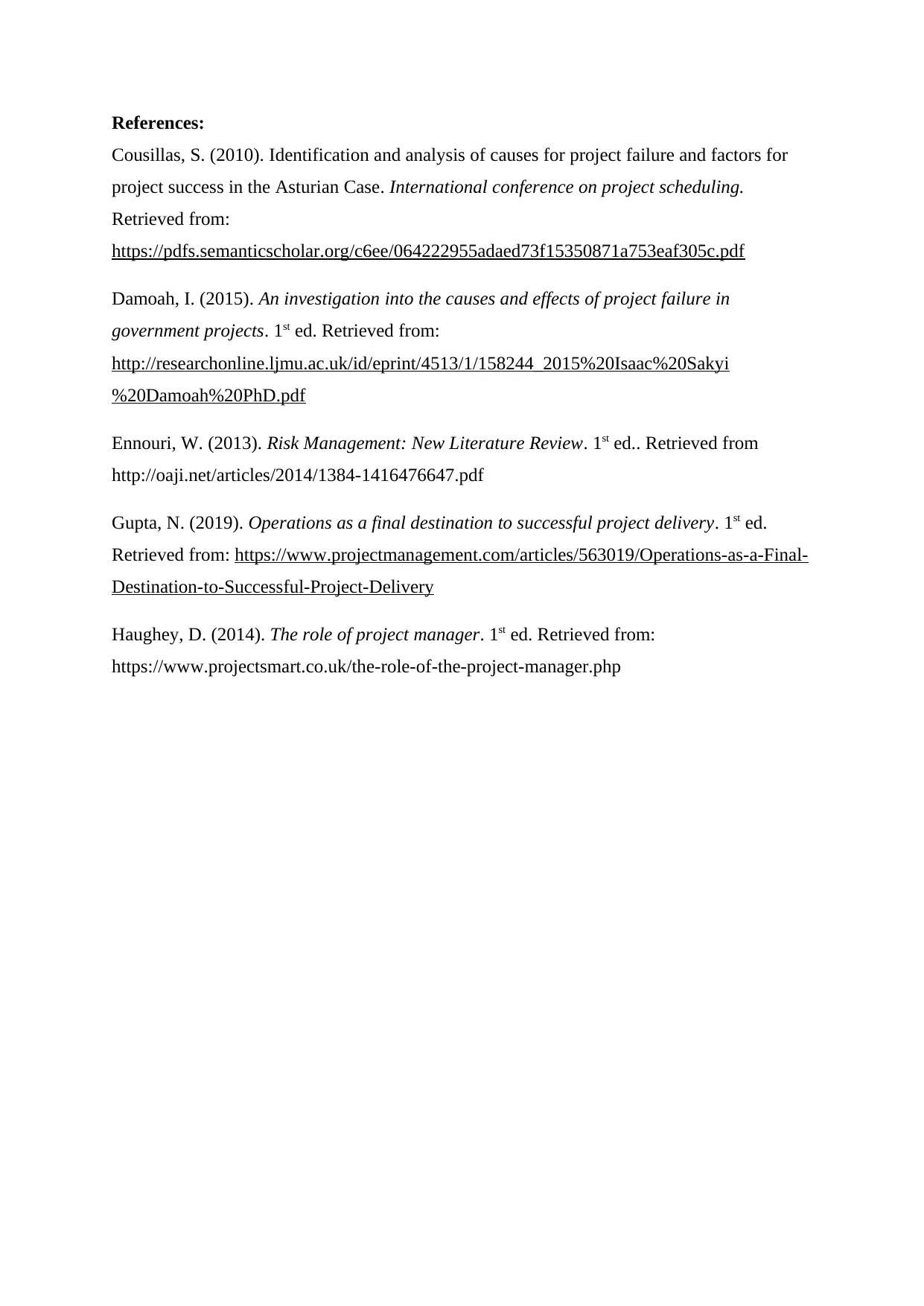
References:
Cousillas, S. (2010). Identification and analysis of causes for project failure and factors for
project success in the Asturian Case. International conference on project scheduling.
Retrieved from:
https://pdfs.semanticscholar.org/c6ee/064222955adaed73f15350871a753eaf305c.pdf
Damoah, I. (2015). An investigation into the causes and effects of project failure in
government projects. 1st ed. Retrieved from:
http://researchonline.ljmu.ac.uk/id/eprint/4513/1/158244_2015%20Isaac%20Sakyi
%20Damoah%20PhD.pdf
Ennouri, W. (2013). Risk Management: New Literature Review. 1st ed.. Retrieved from
http://oaji.net/articles/2014/1384-1416476647.pdf
Gupta, N. (2019). Operations as a final destination to successful project delivery. 1st ed.
Retrieved from: https://www.projectmanagement.com/articles/563019/Operations-as-a-Final-
Destination-to-Successful-Project-Delivery
Haughey, D. (2014). The role of project manager. 1st ed. Retrieved from:
https://www.projectsmart.co.uk/the-role-of-the-project-manager.php
Cousillas, S. (2010). Identification and analysis of causes for project failure and factors for
project success in the Asturian Case. International conference on project scheduling.
Retrieved from:
https://pdfs.semanticscholar.org/c6ee/064222955adaed73f15350871a753eaf305c.pdf
Damoah, I. (2015). An investigation into the causes and effects of project failure in
government projects. 1st ed. Retrieved from:
http://researchonline.ljmu.ac.uk/id/eprint/4513/1/158244_2015%20Isaac%20Sakyi
%20Damoah%20PhD.pdf
Ennouri, W. (2013). Risk Management: New Literature Review. 1st ed.. Retrieved from
http://oaji.net/articles/2014/1384-1416476647.pdf
Gupta, N. (2019). Operations as a final destination to successful project delivery. 1st ed.
Retrieved from: https://www.projectmanagement.com/articles/563019/Operations-as-a-Final-
Destination-to-Successful-Project-Delivery
Haughey, D. (2014). The role of project manager. 1st ed. Retrieved from:
https://www.projectsmart.co.uk/the-role-of-the-project-manager.php
1 out of 7
Related Documents
Your All-in-One AI-Powered Toolkit for Academic Success.
+13062052269
info@desklib.com
Available 24*7 on WhatsApp / Email
![[object Object]](/_next/static/media/star-bottom.7253800d.svg)
Unlock your academic potential
Copyright © 2020–2025 A2Z Services. All Rights Reserved. Developed and managed by ZUCOL.





